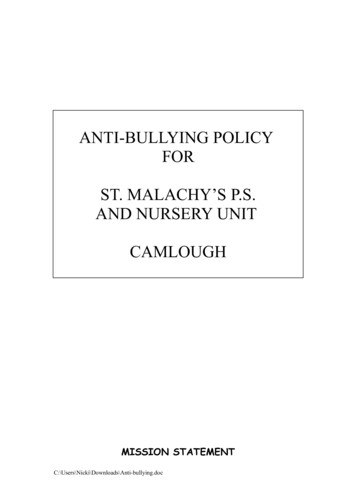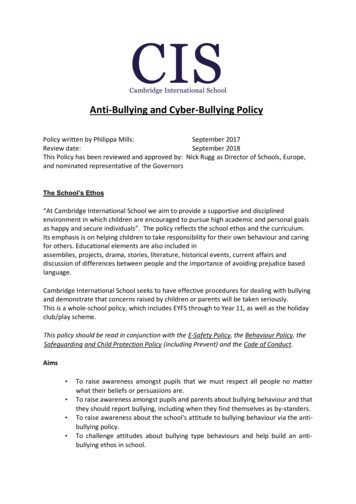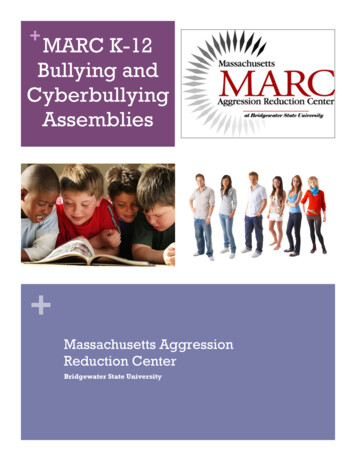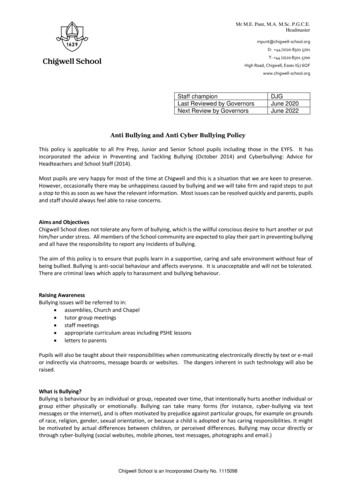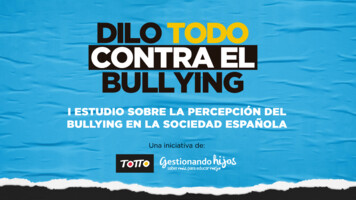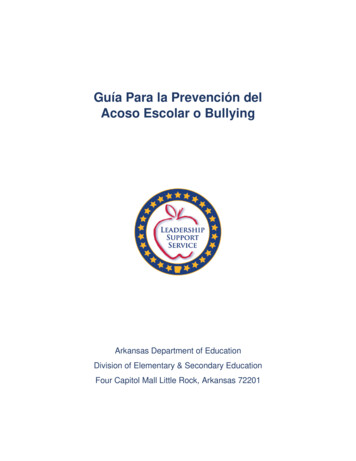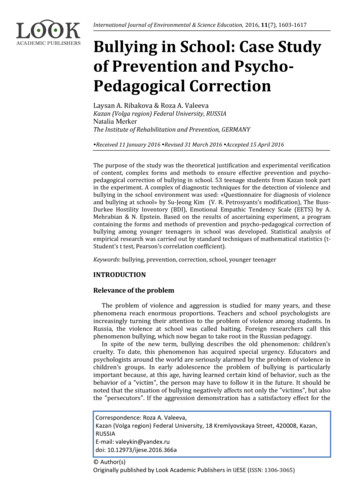
Transcription
International Journal of Environmental & Science Education, 2016, 11(7), 1603-1617Bullying in School: Case Studyof Prevention and PsychoPedagogical CorrectionLaysan A. Ribakova & Roza A. ValeevaKazan (Volga region) Federal University, RUSSIANatalia MerkerThe Institute of Rehabilitation and Prevention, GERMANY Received 11 January 2016 Revised 31 March 2016 Accepted 15 April 2016The purpose of the study was the theoretical justification and experimental verificationof content, complex forms and methods to ensure effective prevention and psychopedagogical correction of bullying in school. 53 teenage students from Kazan took partin the experiment. A complex of diagnostic techniques for the detection of violence andbullying in the school environment was used: «Questionnaire for diagnosis of violenceand bullying at school» by Su-Jeong Kim (V. R. Petrosyants’s modification), The BussDurkee Hostility Inventory (BDI), Emotional Empathic Tendency Scale (EETS) by A.Mehrabian & N. Epstein. Based on the results of ascertaining experiment, a programcontaining the forms and methods of prevention and psycho-pedagogical correction ofbullying among younger teenagers in school was developed. Statistical analysis ofempirical research was carried out by standard techniques of mathematical statistics (tStudent's t test, Pearson’s correlation coefficient).Keywords: bullying, prevention, correction, school, younger teenagerINTRODUCTIONRelevance of the problemThe problem of violence and aggression is studied for many years, and thesephenomena reach enormous proportions. Teachers and school psychologists areincreasingly turning their attention to the problem of violence among students. InRussia, the violence at school was called baiting. Foreign researchers call thisphenomenon bullying, which now began to take root in the Russian pedagogy.In spite of the new term, bullying describes the old phenomenon: children’scruelty. To date, this phenomenon has acquired special urgency. Educators andpsychologists around the world are seriously alarmed by the problem of violence inchildren's groups. In early adolescence the problem of bullying is particularlyimportant because, at this age, having learned certain kind of behavior, such as thebehavior of a "victim", the person may have to follow it in the future. It should benoted that the situation of bullying negatively affects not only the "victims", but alsothe "persecutors". If the aggression demonstration has a satisfactory effect for theCorrespondence: Roza A. Valeeva,Kazan (Volga region) Federal University, 18 Kremlyovskaya Street, 420008, Kazan,RUSSIAE-mail: valeykin@yandex.rudoi: 10.12973/ijese.2016.366a Author(s)Originally published by Look Academic Publishers in IJESE (ISSN: 1306-3065)
L. A. Ribakova, R. A. Valeeva & N. Merkerchild, it can be fixed as the dominant style of behavior in later life. On this basis, itcan be said that school violence (bullying) requires particular attention in the lowteens.In Russian psychological and pedagogical studies, the problem of bullying wasnot researched for a long time. There was not even a scientific term for this problem,since the concept of "baiting " can hardly be attributed to the term “bulling”. In thisregard, although bullying has extreme importance, it is difficult to find informationabout it in the Russian studies. While in the West, the problem of bullying has gainedone of the dominant positions.Some researches call bullying serious acts of aggression, others - any insults andthreats. In any case it is clear that we are talking about a serious and widespreadphenomenon.The media often gives information about the complex situation in schools. We areall more often informed about children bullying teachers and classmates. But in thiscase the newspapers or TV show just the tip of the iceberg. Its main part will onlyappear in the global network or it remains unavailable to the masses. Though theproblem is widely discussed, the real actions to solve it are not observed. Accordingto E. N. Pronin (2008), violent relationships between students in our time aresomething common. Indeed, each school has at least one class, having this problem.Problem statementThe relevance of the chosen topic is determined by the fact that today theproblem of bullying in the school environment becomes wider, affecting all parts ofthe school. Younger teens’ problem of school bullying has its own characteristics.This age is very important for children’s intimate-personal communication andstrengthening their position in the team. In order to get the highest position amongclassmates, some students may use bullying (Kostyunina & Valeeva, 2015).In the situation of bullying younger teens can take one of three forms of deviantbehavior: conformal, victimization or aggression, and accordingly they assume therole of a witness, victim or persecutor (Tagunova et al., 2016). Children, who arevictims of bullying from classmates, don’t often speak about it. That’s why the innercircle of the child should be alert to any changes in the child's behavior, as there arecertain behavioral characteristics typical for victims of bullying.The analysis of scientific literature shows that the prevention and investigation ofthe problem of psycho- pedagogical correction of bullying began in 1905, when thefirst works were published on the topic of school bullying. The pioneers in this area,who conducted the first systematic study of the bullying problems, are Scandinavianscientists D. Olweus (1978), E. Roland & E. Munthe (1989). Moreover, D. Olweus isthe most influential researcher of the bullying problem. Later new researchesappeared in the UK (Tattum & Lane, 1988). In the early nineties of the twentiethcentury particular attention to the problem of bullying is paid in the United States.There is quite a wide variety of definitions of bullying. But there is no indicated,clearly formulated and universally accepted definition of the term. Authors studyingthis phenomenon, give the definition of bullying, based on their understanding.For example, the therapist I. S. Berdyshev gives the following definition ofbulling: "a conscious, sustained violence, not having the character of self-defenseand coming from one or more persons" (Berdyshev, 2005, 3).The sociologist I. S. Kon believes that bullying is "intimidation, physical orpsychological terror that seeks to cause fear in another, and thus subjugate it" (Kon,2006, 15).C. M. Arora (1994) calls bullying the actions that are observable and have a placein the communication between young people at school and are the cause ofresentment and stress.1604 Author(s), International J. Sci. Env. Ed., 11(7), 1603-1617
Bullying in school: case study of prevention and psycho-pedagogical correctionV. E. Besag (1989) investigated the problem of bullying in schools, and concludedthat bullying is a behavior which can be defined as repeated physical, psychological,verbal, or social attacks of those whose power is situational or formally above, onthose who don’t have the possibility to protect themselves, with the intent to causesuffering and to achieve personal satisfaction.Based on the works of D. A. Lane (2001) and E. Roland (1989) the Russianscientist E. P. Ilyin (2014), defines bullying as a systematic long-term physical ormental violence, carried out by one person or group and directed against a personwho is unable to defend himself in the actual situation with the conscious desire tohurt, frighten or to subject prolonged stress.In order to disclose the essence of bullying, it is necessary to consider the"bullying-structure" suggested by E. Roland (1989). It is a social system thatincludes offenders (pursuers, aggressors, hooligans), and their victims andwitnesses (observers)."Offenders"D. Olweus (1978) notes that "offenders" can be described as individuals with highpotential of general aggression. They "attack" not only their victims, but also thefamily and teachers, and have more positive attitude toward aggression than the"witnesses" and "victims". They demonstrate lack of empathy for "victims" and haverelatively high need to dominate over others. The "offenders" also have a strongneed in the management of children and getting satisfaction from theirsubordination.Any child can become a victim, but usually someone who is somehow differentfrom the others or weaker is chosen. The most frequent victims of school violenceare children who have weaknesses in physical development, specific appearance orbehavior. Very often withdrawn children (phlegmatic and introverts) or, conversely,children with impulsive behavior become the victims of ridicule and aggression.Hyperactive children may act both as victims and offenders, and often at the sametime here and there. School phobia, poor social skills, the lack of group interactionexperience (home children), learning difficulties and low intelligence, some diseaseoften make the children victims of bulling."Witnesses"It’s difficult to highlight characteristic features of a "witness". This is due to thefact that in situations of bullying, the majority of children in all its diversity andvariety act as "witnesses". It was revealed that because of the feeling of their ownhelplessness, self-esteem of these children is markedly reduced. Outside observersoften talk about their sense of powerlessness and guilt. S. Askew (1989) argues thatin a situation of bullying not only the "victim" suffers, but surrounding people aswell not having the strength and opportunity to rebuff abuser.Numerous studies show that the manifestations of bullying in school are dueprimarily to the fact that school - is a universal arena, a place for children to releasetheir accumulated home negative impulses. The school children set certain rolerelationships between "a leader and a rogue". Another factor that contributes to thevitality of bullying in school is the inability of teachers to work out this problem.Researchers of school bullying define the following forms in which it isexpressed. Thus, D. A. Lane (2001) speaks of physical and mental violence; I. S.Berdyshev (2005) asserts the existence of behavioral, verbal and actual aggressivebullying, with the presence of physical violence; T. S. Mertsalova (2000) emphasizesthe existence of emotional, physical, verbal and mental abuse.School bullying includes certain actions of the pursuer against a victim, but theyare aimed, according to I. G. Malkina-Pykh (2005), to humiliation by physical,emotional or economic violence and aggression. Let us dwell on the content of eachof the above mentioned types of violence. Author(s), International J. Sci. Env. Ed.,11(7), 1603-16171605
L. A. Ribakova, R. A. Valeeva & N. MerkerPhysical violence is the use of physical force against a student, classmate,resulting in possible severe physical injuries of varying severity. Physical violenceincludes striking, cuffs, beating, slapping, and property damage. As a result of theseactions books, clothing and other personal belongings of the victims may bedamaged, stolen or hidden. In some cases, they use of the weapon, for exampleknives. According to I. G. Malkina-Pykh (2005), this behavior is more commonamong boys. Very often physical violence is accompanied by emotions. The use ofphysical force may continue for a long time, thus causing the victims’ traumaticexperiences.Emotional abuse, causing the victim's emotional stress, lowers his self-esteemand humiliates him. In this case, the main weapon is the voice. There are severaltypes of emotional abuse:- refusal of communication with the victim, isolation, rejection. As a rule, the useof this method initiates a bully. The victim is deliberately ignored by a part of a classor a class, he is expelled or isolated. It is often accompanied by humiliating sloganson the board or in public places, whispered insults that can be heard by the victim,the spread of the notes that have offensive content. In this case, they refuse to dealwith a child, Don’t play with him, don’t invite him/her to birthday parties, do notwant him to sit at the same desk, etc.;- biased evaluation and endless notes, assigning nicknames, which are constantlyturning to the child, thereby insulting and injuring him, ridicule, mockery,humiliation in front of other children, and so on. This kind of bullying is often usedagainst the victims, having high or low academic performance, obvious differencesin physical appearance, accent or voice features. Name-calling can also be in theform of hints about the student’s alleged sexual orientation. The use of anonymousphone calls - quite a common form of verbal bullying, when not only students, buteven teachers may become victims;Economic violence presupposes the use of money to control another person. Inthis case the victim is demanded money, and if he/she does not give it immediately,threats followed. In school breakfasts, money or coupons for lunch can also beextorted. It is also possible to force the victim to steal property. This tactic is usedsolely to make blame fall on the victim.Researcher O. A. Maltseva (2009) writes about a new kind of school bullying –cyber-bulling, i.e. victim receives abuse by e-mail or through other electronicdevices.Thus, bullying can be considered as intentional, repeated (long ), psychological orphysical violence, not having the character of self-defense or authorized byregulations of the state, which comes from one person or group having certainadvantages (administrative, psychological, physical) with respect to a person, andwhich occurs mainly in organized groups with a specific personal goal.Bullying is largely hidden to others process, but because of its latency it is notless dangerous. Children, who are subjected to harassment, may receivepsychological trauma of varying severity, with possible negative consequences. Itdoes not matter whether it was physical or psychological bullying. Preventing schoolviolence is one of the most important tasks of the teaching staff, as the crueltreatment of a child inevitably leads to serious consequences.Analysis of the problem of bullying in psychological and pedagogical literatureand practice made possible to reveal a contradiction between the increasing needfor active work aimed at combating school violence and the insufficientdevelopment of the content, forms and methods of preventive and corrective workaimed at reducing bullying in school.1606 Author(s), International J. Sci. Env. Ed., 11(7), 1603-1617
Bullying in school: case study of prevention and psycho-pedagogical correctionMETHODSThe tasks of the researchThe purpose of the study was the theoretical justification and experimentalverification of content, complex forms and methods to ensure effective preventionand psycho-pedagogical correction of bullying in school.Theoretical and empirical methodsIn compliance with the goal, the following methods have been selected:1) theoretical (study and analysis of pedagogical and psychological literature onthe study, comparison, generalization),2) empirical (notes forming, control experiment).The results were processed with Student’s t-criterion.In order to identify violence and bullying in the school environment,“Questionnaire for diagnosis of violence and bullying at school” by Su-Jeong Kim (V.R. Petrosyants’s modification) (Kim, 2004; Petrosyants, 2011), the Buss-DurkeeHostility Inventory (BDI) (Buss & Durkee, 1957), Emotional Empathic TendencyScale (EETS) by A. Mehrabian & N. Epstein (Mehrabian & Epstein, 1972) were used.Questionnaire for diagnosis of violence and bullying at school by Su-Jeong Kim(2004) (Petrosyants’s (2011) modification) consists of two parts . The first part –"Violence in Schools" (12 points), the second – "The situation of bullying at school"(11 points). This modification provides an assessment of most of the indicators ofbullying, we have reflected in the theoretical review. Its purpose is to study thefrequency of violence (psychological and physical), experienced and shown by achild, as well as realizing himself a persecutor or a victim of psychological / physicalviolence. The questionnaire addresses issues that evaluate experience in bullyingand are taken from the questionnaire by T. Kwak & S. Lee (1988), some questionswere added by the author from the modified version. Furthermore, V. R. Petrosyants(2011) took questions about the frequency of bullying by different methods (7points) from the D. Olweus’s questionnaire (Olweus, 1978). Methods passed theprocedure of checking the validity and reliability of the questionnaire.«Questionnaire for diagnosis of violence and bullying at school» by Su-Jeong Kim(2004) (Petrosyants’s (2011) modification) reveals the following levels of bullyingamong students:100-71 points –a high level of the bullying problem. Children point out thepresence of violence in school, a variety of types of bullying in relation to thestudents. Children experience negative emotions, fear, hatred, anger, horror,depression, apathy. Children note the presence of physical and mental violence.70-40 points – the average level is characterized by the presence of violence inschool; children experience negative emotions and the desire to respond in the sameway; physical violence is dominating.39-0 points – the lowest level is characterized by stable emotional atmosphere,the lack of physical and mental violence, the absence of negative emotions.The Buss-Durkee Hostility Inventory (BDI) (Buss & Durkee, 1957) reveals thefollowing reactions: physical aggression (the use of physical force against anotherperson); indirect aggression aimed detour to another person; irritation (awillingness to manifest negative feelings at the slightest excitation (temper,rudeness); negativism (opposition in the manner of behavior from passive to activestruggle against the established customs and laws); resentment (envy and hatred ofthe real and imaginary deeds); suspicion (from mistrust and caution in relation tothe others to the belief that other people are planning to bring harm); verbalaggression (verbal expression of negative feelings); guilt expressing the person’s Author(s), International J. Sci. Env. Ed.,11(7), 1603-16171607
L. A. Ribakova, R. A. Valeeva & N. Merkerconviction- being a bad man that went wrong, as well as his pricks of conscience.The technique also allows you to allocate the index of hostility (resentment andsuspicion) and the index of aggression (physical aggression, anger, verbalaggression).Emotional Empathic Tendency Scale (EETS) by A. Mehrabian & N. Epstein (1972)consists of 33 proposals, approvals. During the study of the younger teens’ capacityfor empathy, four groups were distinguished: a high level of empathic tendencies,the average level of empathic tendencies, low empathic tendencies, very low level ofempathic tendencies.The trial infrastructure and stages of the researchAn empirical study was conducted on the basis of the Gymnasium 40 in Kazan(Republic of Tatarstan, Russia). 53 junior teenagers took part in the experiment. Thestudy was conducted in three stages: ascertaining, formative and controlling.The aim of ascertaining experiment was to determine the baseline empathictendencies, indicators of aggressiveness of adolescents, the level of bullying, and theoverall presence of bullying in a group. Based on these results the program wasdeveloped containing a variety of forms and methods of prevention and psychopedagogical correction of bullying in school.The purpose of the formative experiment was testing the program "Hand inHand", aimed at the prevention and psycho-pedagogical correction of bullying inschool. In the control phase of our experiment, we evaluated the effectiveness of theforms and methods of prevention and psycho-pedagogical correction of youngerteenagers’ bullying. At this stage, we have identified the level of all the studiedparameters and studied their dynamics.Comparing the results that were obtained on ascertaining and control stages ofthe experiment, it was found out whether the correct forms and methods of psychopedagogical correction were applied and how they had reduced the situation ofbullying in school. The experimental study was carried out in natural conditions ofthe educational process of the school.Experimental procedure and its descriptionInitially, respondents were asked to answer the “Questionnaire for diagnosis ofviolence and bullying at school” by Su-Jeong Kim (V. R. Petrosyants’s modification)(Kim, 2004; Petrosyants, 2011).With this technique, we identified particular manifestations of bullying in school,how respondents react in the situation of bulling, their attitudes, as well as howoften they exposed bulling.Next to that, we used the Buss-Durkee Hostility Inventory (BDI) (Buss & Durkee,1957) to identify different types of aggression, characteristic of teenagers.Responses are measured on eight scales as follows:1. Physical aggression: "yes" 1, "no" 0: 1, 25, 31, 41, 48, 55, 62, 68; "no" 1,"да" 0: 9 и 7.2. Indirect aggression: "yes" 1, "no" 0: 2, 10, 18, 34, 42, 56, 63; "no" 1 "no" 0: 26, 49.3. Irritation: "yes" 1, "no" 0: 3, 19, 27, 43, 50, 57, 64, 72; "no" 1, "yes" 0: 11,35, 69.4. Negativism: "yes" 1, "no" 0: 4, 12, 20, 28; "no" 1, "yes" 0: 36.5. Resentment: "yes" 1, "no" 0: 5, 13, 21, 29, 37, 44, 51, 58.6. Suspiciousness: "yes" 1, "no" 0: 6, 14, 22, 30, 38, 45, 52, 59; "yes" 0, "no" 1: 33, 66, 74, 75.1608 Author(s), International J. Sci. Env. Ed., 11(7), 1603-1617
Bullying in school: case study of prevention and psycho-pedagogical correction7. Verbal aggression: "yes" 1, "no" 0: 7, 15, 23, 31, 46, 53, 60, 71, 73; "yes" 0,"no" 1: 33, 66, 74, 75.8. Feeling guilty: "yes" 1, "no" 0: 5, 8, 16, 24, 32, 40, 47, 54, 61, 67.Hostility index includes 5 and 6 of the scale and the aggressiveness index(straight or motivational) includes a scale 1 , 3, 7 - S.The norm value of aggression index is equal to 18 - 21 4, and hostility - 6.5 - 7 3. At the same time it demonstrates the possibility of reaching a certain size,showing the degree of aggressiveness manifestation.To determine the teenagers’ level of empathy the Emotional Empathic TendencyScale (EETS) by A. Mehrabian & N. Epstein (Mehrabian & Epstein, 1972) was used.Since we need to define a common indicator of the presence of bullying in agroup test, we conducted a mathematical process of counting. When dividing thesample into three groups as central subgroups we divided the subjects for which theindicator value xi is within хср σхThe availability of bullying in adolescents is defined as follows: the low level 1-5score average: 11.6 points, the highest level: 12-15 points.RESULTS AND DISCUSSIONSDuring testing of the study group, a high level of empathic tendencies in theascertaining stage of the study (from 33 to 26 points – for boys, from 33 to 30 points– for girls) was identified in 8 teenagers, accounting for 15.1% of the total number.The average level of empathic tendencies (from 25 to 17 points – for boys, from 29to 23 points – for girls) was detected in 15 children, accounting for 28.3% of thetotal number. Low level of empathic tendencies (from 16 to 8 points – for boys; 22 to17 points – for girls) was detected in 25 teenagers, accounting for 47.2% of the totalnumber of participants. Very low level of empathic tendencies (7 to 0 points – forboys; 16 to 0 points – for girls) was detected in 5 people, or 9.4% of the total numberof children.Thus, if in the aggregate to take into account the low and very low level ofempathic tendencies in the studied group of teens, low level of empathy dominated.The boys say that people exaggerate the animals' ability to feel and experience; if afriend or girlfriend begin to discuss their problems, they try to turn the conversationto another topic; it is frustrating when people watching a movie sigh and cry;someone's laughter does not infect them; when they make a decision, the opinion ofother people, as a rule, does not matter. So there is a necessity of special work toincrease the young adolescents’ level of empathy.The next stage of our study was to investigate the aggressive reactions ofadolescents in the ascertaining phase of the experiment. The dominant aggressivereactions in the group of teenagers is suspicion (12.8), ranging from mistrust andcaution against people to the belief that other people are harmful; verbal aggression(10.2), as the expression of negative feelings through the form (a cry, squeal ), andthrough the verbal content of the responses (curses, threats); offense (5.6) , jealousyand hatred of others for real and imaginary action; guilt (5.6) expresses the possibleconviction of the child that he is a bad man acting badly, as well as his feel remorse.52.8% of participants say that they know what people are saying about thembehind their backs; 60.4% of teens say that they stay cautious with people who treatthem a little more friendly than they are expected; 62.3 % think that many people donot like them; 49.1% believe that many people envy them; 45.3% of participantsthink that they are laughed at; 37.7% of teens say that their principle is "Never truststrangers".41.5% of the participants said that, if they do not approve their friends’ behavior,then they let them feel it; 34% of the children often do not agree with the people;49.1% of them could not resist the dispute, if people do not agree with them; 67.9% Author(s), International J. Sci. Env. Ed.,11(7), 1603-16171609
L. A. Ribakova, R. A. Valeeva & N. Merkerof adolescents require people to respect them; 77.4% of teens say that if someoneannoys them, they will talk about it; 73.6% of participants say that when someonecries, they start screaming in response; 32.1% of adolescents swear only by anger;45.3% of teens often only threaten people, although they are not going to executethe threat; 71.7% of adolescents in the dispute often raise their voices.86.8% of teens say they do not always get what they are entitled to; 88.7% ofparticipants say that others are almost always able to use favorable circumstances;39.6% of teens say they are a little bit distressed by their fate; 83% of participantssay that almost every week meet someone they do not like; 30.2% of teens say thatthey are sometimes consumed with envy although they don’t show it; 45.3% ofteens say that if everyone knew what they felt they would consider them a personwho is not easy to get along with; 71.7% of adolescents sometimes feel that life goeswith them unfairly.49.1% of teens say that when they happened to deceive anyone, they haveexperienced a painful remorse; 37.7 % of teens say that sometimes they come tothoughts they are ashamed of; 32.1% of children are upset of doing little for theirparents; 28.3% of participants say they are doing a lot of things they regret aboutlater; 43.4% of teens say that they are distressed by failure; 45.3% of the teens pointout that when they do wrong, they feel moral qualms.In addition, we found out that aggressiveness index in the group was 47.2%,while the index of hostility – 52.8%. Thus, the aggressive reactions of the subjects inthe group are high, as well as the level of aggression.The next stage of our study was to determine the level of bullying in the group onthe ascertaining stage of the study. We found out that a high level of bullying isdominated in the group (49.1% - 26 adolescents). Children point out the presenceof violence in schools, a variety of types of bullying in interrelation, negativeemotions. Children experience fear, hatred, anger, horror, depression, apathy; theynote the presence of physical and mental violence.The average level of bullying in the group amounted to 32.1% (17 adolescents).The average level is characterized by the presence of violence in school, childrenexperience negative emotions and the desire to respond in the same way, physicalviolence is dominating.The low level bullying in the group before the experiment was 18.8% (10adolescents). It is characterized by the stability of the emotional atmosphere, thelack of physical and mental violence, the absence of negative emotions.45.3% of the children believe that the problem of school violence does exist.Among the most common forms of violence they called rudeness (60.4%), mockery(52.8%) and humiliation (49.1%). Among the less common – deliberate destructionof another's property (9.4%), isolation (6.5%), and pushing down the stairs (4.3%).Moreover, 62.3% of children have a desire to respond in the same way. As for thechildren’s sense of security in school, 67.9% answered that it depended oncircumstances, and 32.1% called it total. 49.1% of students experienced physicalviolence once or twice, 28.3% – once a month. As for psychological violence, 71.7%of respondents felt it once or twice, 32.1% once a month, and 17% – once a week.30.2% of children said that during the current half-year they were subjected toharassment once a week, 60.4% – several times over the same period. At the sametime 17% do not know why they are bullied by other students, 9.4% believe that it isdue to the fact that they ignore them and the teacher likes them more, 18.8% thinkit’s because they often quarrel with others, and 3.8% see the reason in the theirfinancial position, in the specificity of the appearance and because they considerthemselves better than the other students. 20.8% of bullied pupils pretend thatnothing happened, 28.3% avoid places where it occurs, 15.1% don’t talk anyone, and8.6% are trying to explain that one cannot act this way and 3.8% miss school.1610 Author(s), International J. Sci. Env. Ed., 11(7), 1603-1617
Bullying in school: case study of prevention and psycho-pedagogical correctionAmong the methods used by the students to solve the problem of harassment,they call harassment opposition and talking about it with parents (28.3%), talkingwith the teachers (24.5%), and patience (18.8%). 62.3% of students witnessedbullying in the cl
pedagogical correction of bullying in school. 53 teenage students from Kazan took part in the experiment. A complex of diagnostic techniques for the detection of violence and bullying in the school environment was used: «Questionnaire for diagnosis of violence and bullying at school» by Su-Jeong Kim (V. R. Petrosyants's modification), The Buss-

